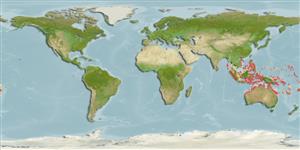>
Ovalentaria/misc (Various families in series Ovalentaria) >
Pomacentridae (Damselfishes) > Pomacentrinae
Etymology: Pomacentrus: Greek, poma, -atos = cover, operculum + Greek, kentron = sting (Ref. 45335).
More on author: Fowler.
Environment: milieu / climate zone / rango de profundidad / distribution range
Ecología
marino asociado a arrecife; no migratorio; rango de profundidad 2 - 12 m (Ref. 7247). Tropical; 19°N - 24°S
Western Pacific: Philippines, New Guinea, Rowley Shoals, Great Barrier Reef, and Palau (Belau), Truk, and Pohnpei in Micronesia.
Tamaño / Peso / Age
Madurez: Lm ? range ? - ? cm
Max length : 9.0 cm SL macho / no sexado; (Ref. 7247)
Short description
Claves de identificación | Morfología | Morfometría
Espinas dorsales (total) : 13; Radios blandos dorsales (total) : 14 - 15; Espinas anales: 2; Radios blandos anales: 14 - 15.
Body shape (shape guide): short and / or deep; Cross section: compressed.
Adults inhabit lagoons and passages among branching corals. They occur solitarily or in small groups. Feed mainly on benthic algae (Ref. 7247). Oviparous, distinct pairing during breeding (Ref. 205). Eggs are demersal and adhere to the substrate (Ref. 205). Males guard and aerate the eggs (Ref. 205). Diurnal species (Ref. 113699).
Life cycle and mating behavior
Madurez | Reproducción | Puesta | Huevos | Fecundidad | Larva
Oviparous, distinct pairing during breeding (Ref. 205). Eggs are demersal and adhere to the substrate (Ref. 205). Males guard and aerate the eggs (Ref. 205).
Allen, G.R., 1991. Damselfishes of the world. Mergus Publishers, Melle, Germany. 271 p. (Ref. 7247)
IUCN Red List Status (Ref. 130435: Version 2024-2)
Threat to humans
Harmless
Human uses
Pesquerías: sin interés
Herramientas
Special reports
Download XML
Fuentes de Internet
Estimates based on models
Preferred temperature (Referencia
123201): 25.6 - 29.3, mean 28.6 °C (based on 1764 cells).
Phylogenetic diversity index (Referencia
82804): PD
50 = 0.5000 [Uniqueness, from 0.5 = low to 2.0 = high].
Bayesian length-weight: a=0.02455 (0.01155 - 0.05216), b=2.98 (2.81 - 3.15), in cm total length, based on LWR estimates for this Genus-body shape (Ref.
93245).
Nivel trófico (Referencia
69278): 2.7 ±0.31 se; based on food items.
Resiliencia (Referencia
120179): Alto, población duplicada en un tiempo mínimo inferior a 15 meses (Preliminary K or Fecundity.).
Fishing Vulnerability (Ref.
59153): Low vulnerability (10 of 100).
🛈
Nutrients (Ref.
124155): Calcium = 130 [64, 206] mg/100g; Iron = 0.792 [0.473, 1.332] mg/100g; Protein = 18.2 [17.0, 19.3] %; Omega3 = 0.108 [0.062, 0.180] g/100g; Selenium = 19.1 [10.6, 37.3] μg/100g; VitaminA = 102 [28, 340] μg/100g; Zinc = 1.94 [1.30, 2.86] mg/100g (wet weight);
